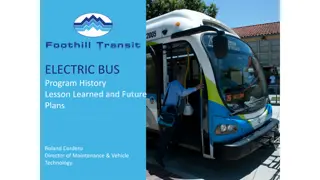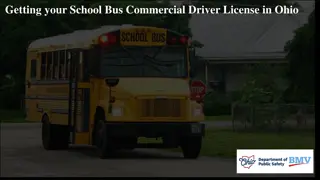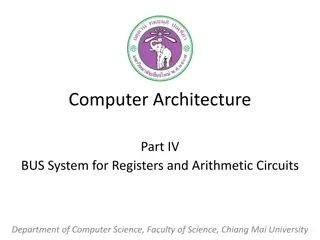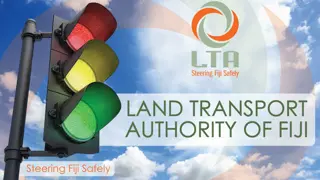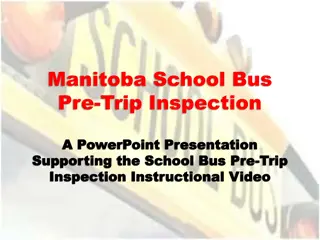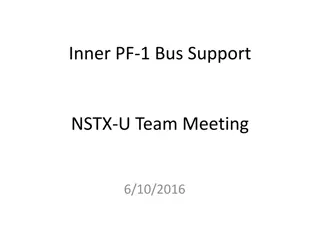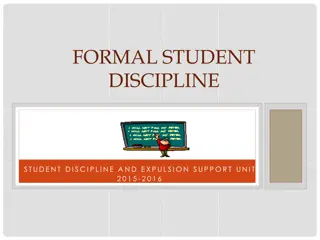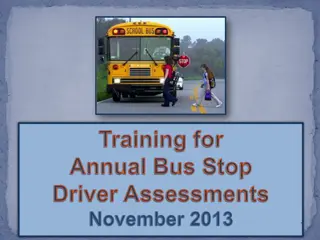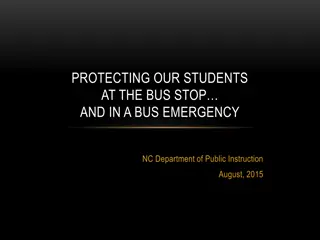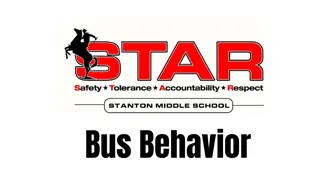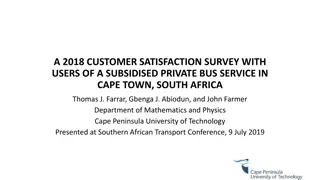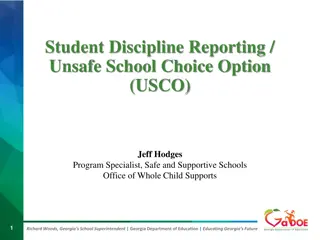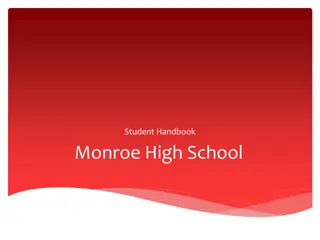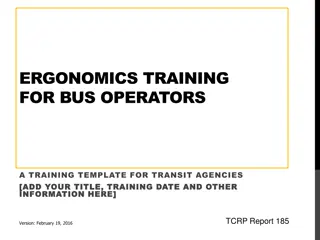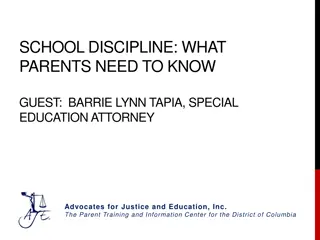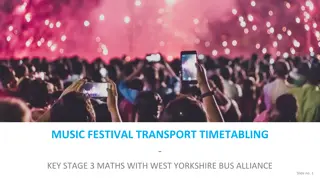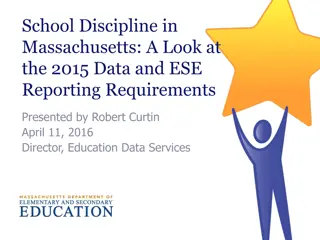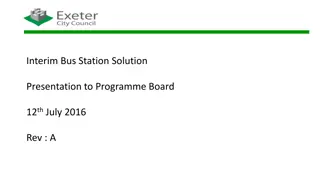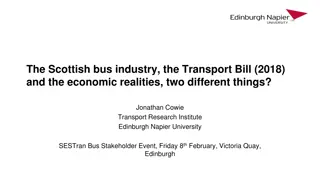School Bus Conduct and Discipline Policies for Students
This document outlines the policies and procedures regarding school bus conduct and discipline for students. It covers rules such as following the bus driver's instructions, no eating or drinking on the bus, keeping the bus clean, and refraining from bullying or cyberbullying. The progressive discipline procedure for bus misbehavior is also detailed, with consequences ranging from written incident reports to short-term and long-term denials of bus privileges. Security cameras are in place on buses to ensure safety and deter disruptive behavior.
Download Presentation

Please find below an Image/Link to download the presentation.
The content on the website is provided AS IS for your information and personal use only. It may not be sold, licensed, or shared on other websites without obtaining consent from the author.If you encounter any issues during the download, it is possible that the publisher has removed the file from their server.
You are allowed to download the files provided on this website for personal or commercial use, subject to the condition that they are used lawfully. All files are the property of their respective owners.
The content on the website is provided AS IS for your information and personal use only. It may not be sold, licensed, or shared on other websites without obtaining consent from the author.
E N D
Presentation Transcript
2019-2020 Policies and Procedures Bus Conduct/Discipline Bullying/Cyberbullying Electronic Signaling Devices Sexual Harassment Student Acceptable Use Policy for Technology, Online Services, and Internet Access Student Dress Code Safety Plan - Immediate Response Action
Bus Conduct/Discipline Procedures Bus Rules and Regulations General Rules of Bus Conduct for Students 1. Follow the bus driver s instructions at all times. 2. Cross the highway or private road ONLY under the direct supervision of the bus driver. 3. Students shall enter and exit the bus in an orderly manner. 4. There is to be no slapping, hitting, shoving or other distracting behavior at any time. Keep hands, head, and all objects inside the bus at all times. 5. No object of any kind is to be thrown outside or inside of the bus. 6. Keep the bus clean and in good condition. 7. Students are not to shout or make offensive remarks to pedestrians or motorists. Be courteous and respectful to all people.
Bus Conduct/Discipline Procedures 8. Bus Rules and Regulations General Rules of Bus Conduct for Students 9. Eating, drinking, or gum chewing is not allowed at any time on the bus. 10. Wrestling/horse-play/fighting is not allowed on the bus or at any bus stop. 11. Feet, hands, books, etc., are to be kept clear of the aisle. 12. Students are NOT permitted to take live animals or any other item, which would cause a disturbance on the bus. 13. Use of profane language will not be permitted. 14. Students are to promptly report any damage to seats or other parts of the bus near where they are sitting to avoid being charged with responsibility for such damage. 15. Behave in a manner that will keep others safe while on the bus, waiting at the bus stop, when leaving the bus, or crossing roads. NOTICE OF THE USE OF SECURITY CAMERAS McCabe Union School District has installed video surveillance cameras in the school buses. These cameras were installed to promote safety and deter disruptive or inappropriate behavior on the buses. The cameras record when buses are transporting students.
Bus Conduct Referral Progressive Discipline Procedure Step 1 Written incident report to transportation supervisor, copy in file, copy sent home to parent/guardian Step 2 Written incident report to: Transportation supervisor and parent contacted Step 3 Referred to superintendent/principal for warning of pending denial of bus privileges Step 4 Short-term denial (5 days) Step 5 Long-term denial (30 days) The above procedures are enforced for MINOR bus behavior infractions. All MAJOR bus misbehavior will result in immediate denial of bus privileges.
Bullying and Cyberbullying No individual or group shall, through physical, written, verbal, or other means, harass, sexually harass, threaten, intimidate, retaliate, cyberbully, cause bodily injury to, or commit hate violence against any student or school personnel. Cyberbullying includes the creation or transmission of harassing communications, direct threats, or other harmful texts, sounds, or images on the Internet, social media, or other technologies using a telephone, computer, or any wireless communication device. Cyberbullying also includes breaking into another person's electronic account and assuming that person's identity in order to damage that person's reputation. Students are encouraged to notify school staff when they are being bullied or suspect that another student is being victimized.
Bullying and Cyberbullying Continued When the circumstances involve cyberbullying, individuals with information about the activity shall be encouraged to save and print any electronic or digital messages that they feel constitute cyberbullying and to notify a teacher, the principal, or other employee so that the matter may be investigated. When a student uses a social networking site or service to bully or harass another student, the Superintendent or designee may file a request with the networking site or service to suspend the privileges of the student and to have the material removed. Discipline actions for a student who commits an act of bullying of any type may include counseling, behavioral intervention and education, and, if the behavior is severe or pervasive as defined in Education Code 48900, may include suspension or expulsion in accordance with district policies and regulations.
Electronic Signaling Devices The possession of any electronic signaling device is strictly prohibited during all instructional activities, during all school-sponsored activities, and while riding in any district vehicle. For the purposes of this policy, the term electronic signaling device is any device that operates through the transmission or receipt of radio waves, including, but not limited to, pagers, cellular telephones, two- way radios, and e-mail communicators.
Electronic Signaling Devices Confiscation Electronic devices which are used in violation of this policy are subject to confiscation by any employee of the District. Any device which is confiscated shall be turned over to an Administrator for securing. Recovery Any device which has been confiscated and delivered to Administration may be recovered under the following conditions: 1st Offense: A parent or guardian must come to the school office, no earlier than the end of the same school day on which the device was confiscated, and meet with the school administrator to pick up the item. 2nd Offense: The item will be stored in the school office for a period of fourteen school days prior to being eligible for return. The student and parent/guardian will meet with administration to discuss the violation and review the school s policy. Additional Offenses: The student will be suspended for violation of Education Code 48900(k), Disrupted school activities or otherwise willfully defied the valid authority of supervisors, teachers, administrators, other school officials, or other school personnel engaged in the performance of their duties.
Sexual Harassment The district strongly encourages any student who feels that he/she is being or has been sexually harassed on school grounds or at a school-sponsored or school-related activity by another student or an adult who has experienced off-campus sexual harassment that has a continuing effect on campus to immediately contact his/her teacher, the principal, or any other available school employee. Prohibited sexual harassment includes, but is not limited to, unwelcome sexual advances, unwanted requests for sexual favors, or other unwanted verbal, visual, or physical conduct of a sexual nature made against another person of the same or opposite sex in the educational setting, under any of the following conditions: (Education Code 212.5; 5 CCR 4916) Submission to the conduct is explicitly or implicitly made a term or condition of a student's academic status or progress. Submission to or rejection of the conduct by a student is used as the basis for academic decisions affecting the student. The conduct has the purpose or effect of having a negative impact on the student's academic performance or of creating an intimidating, hostile, or offensive educational environment. Submission to or rejection of the conduct by the student is used as the basis for any decision affecting the student regarding benefits and services, honors, honors, programs, or activities available at or through any district program or activity.
Sexual Harassment Examples of types of conduct which are prohibited in the district and which may constitute sexual harassment include, but are not limited to: 1. Unwelcome leering, sexual flirtations, or propositions 2. Unwelcome sexual slurs, epithets, threats, verbal abuse, derogatory comments, or sexually degrading descriptions 3. Graphic verbal comments about an individual's body or overly personal conversation 4. Sexual jokes, derogatory posters, notes, stories, cartoons, drawings, pictures, obscene gestures, or computer-generated images of a sexual nature 5. Spreading sexual rumors 6. Teasing or sexual remarks about students enrolled in a predominantly single-sex class 7. Massaging, grabbing, fondling, stroking, or brushing the body 8. Touching an individual's body or clothes in a sexual way 9. Impeding or blocking movements or any physical interference with school activities when directed at an individual on the basis of sex 10. Displaying sexually suggestive objects 11. Sexual assault, sexual battery, or sexual coercion 12. Electronic communications containing comments, words, or images described above
Acceptable Use Policy for Technology If students see a message, comment, image, or anything else online that makes them concerned for their personal safety, they should bring it to the attention of an adult (teacher or staff at school; parent at home) immediately. Security - Students are expected to take reasonable safeguards against the transmission of security threats over the school network. This includes not opening or distributing infected files or programs and not opening files or programs of unknown or untrusted origin. If a student believes a computer or mobile device might be infected with a virus, they should alert a teacher. Students should not attempt to remove the virus or download any programs to help remove the virus. Downloads - Students should not download or attempt to download any files, programs, or software updates, or run .exe programs over the school network or onto school resources, even if prompted to do so by the computer or device being used. Teachers may give students special permission to download images or videos. For the security of the network, such files should only be downloaded from sites provided by the teacher, and only for education purposes.
Acceptable Use Policy for Technology Netiquette - Students should always use the Internet, network resources, and online sites in a courteous and respectful manner. Students should also recognize that among the valuable content online is unverified, incorrect, or inappropriate content. Trusted sources should be used when conducting research via the Internet. Teachers or library staff can help with this. Plagiarism - Students should not plagiarize (or use as their own, without citing the original creator) content, including words or images, from the Internet. Students should not take credit for things they didn t create themselves, or misrepresent themselves as an author or creator of something found online. Research conducted via the Internet should be appropriately cited, giving credit to the original author. Personal Safety - Students should never share personal information, including phone number, address, social security number, birthday, pictures, or financial information over the Internet without adult permission. Students should recognize that communicating over the Internet brings anonymity and associated risks, and should carefully safeguard the personal information of themselves and others. Users should never agree to meet someone they meet online in real life without parental permission.
Acceptable Use Policy for Technology Violations of this Acceptable Use Policy Violations of this policy may have disciplinary repercussions, including: Suspension of network, technology, or computer privileges Notification to parents E 6163.4(f) STUDENT USE OF TECHNOLOGY (continued) Detention or suspension from school and school-related activities Legal action and/or prosecution
Student Dress Code Students are expected to attend school in clean, neat clothing. It is the mission of the school district not only to provide academic education but also to provide education in morals, manners, dress and grooming because these are elements of good citizenship. Research has shown that student dress and appearance affect student attitudes and conduct. These guidelines are intended to define "appropriate student attire" and personal grooming. Their purpose is to prevent disruption of the classroom atmosphere, enhance classroom decorum, eliminate disturbances among other students in attendance and minimize distraction of other students so as not to interfere with the educational process. It is also intended to help protect the health and welfare of the individual student.
Student Dress Code Violation of the dress code will result in appropriate disciplinary action including by not limited to the following: change of clothes, parent notification, detention, parent conference. The following guidelines shall apply to all regular school activities: 1. Clothing, jewelry, and personal items shall be free of writing, pictures, or any other insignia which is vulgar, lewd, obscene, profane, or sexually suggestive or which promotes the use of alcohol, drugs, tobacco, or other illegal activity. 2. Appropriate shoes must be worn at all times. For safety purposes, shoes must have an enclosed heel or a heel straps. 3. Hats, caps, and other types of head covering shall not be worn inside buildings. Hats are not to be worn backwards. 4. Hair shall be clean and neatly groomed. Dress, hair style, hair color, or makeup which are of a disruptive nature or that interfere with the educational school day are NOT permitted. Hair may not be sprayed with any coloring. Aerosol cans of hair color are not permitted at school.
Student Dress Code 5. Sunglasses are approved for campus wear, but are not to be worn inside buildings. 6. All clothing shall be within the bounds of decency and good taste as appropriate for school. Garments shall be sufficient to conceal under-garments. a. Dresses, skirts, and shorts must be mid-thigh or longer b. Shorts, pants, skirts shall have no writing across the seat area. c. All students must wear appropriately fitting athletic clothes - no excessively tight or oversized shirts/shorts.
Student Dress Code d. Wearing of shirts: T-shirts and polo type shirts that are not tucked-in shall not extend below the pockets of pants or shorts. Shirts should not expose bare abdomen. As a test for appropriate length, have the student raise their arms above their head. If this reveals a bare abdomen, then the top is too short. ii. Tops and dresses with low cut necklines at the front, back, or shoulders are not permitted. All straps must be two inches (2") or greater; this includes tube tops, spaghetti strap tops, tank tops with narrow straps, racerback tank tops, halter tops, and/or any strapless top or dress which reveal the midriff or breast are neither acceptable nor permitted. iii. Camisoles are considered undergarments and straps must be under a 2" tank top. No under shirts shall be worn as outerwear. iv. No "see through" or "fishnet" type of blouse or shirt may be worn. Sheer tops must be worn with a two-inch (2") tank top underneath. i.
Student Dress Code e. Wearing of Shorts - Students will be allowed to wear Bermuda shorts, walking shorts, or shorts of this type within the following guidelines: i. Shorts must be mid-thigh or longer ii. If the shorts have slits or notches, tops of the slits or notches cannot be above mid-length iii. Shorts must be hemmed and straight legged. iv. Shorts with length below the knee are not allowed
Student Dress Code f. Wearing of Pants: i. Jeans cannot be cut or ripped above mid-thigh, exposing thigh region. ii. Leggings and yoga pants are considered an undergarment and must be covered by another garment (longer shirt, skirt, shorts, or dress) that must be no shorter than mid-thigh. iii. All long pants must be the proper waist size, length, and leg size. iv. The pants waist size must not be more than one inch bigger than the correctly measured student waist size. Pants cannot be gathered or drawn together at the waist and must not hang below the waist. v. To check if the pants are oversized in the leg, take a measuring tape and pull the pants tight at the calf muscle. If the excess pants material that can be gathered up measures five (5) inches or more they are too big and are not acceptable for school. vi. Pant inseams must be appropriately sized for the student. Pant length should not touch or drag on the ground. vii. Students wearing overalls or other bib-type attire must have the straps buttoned appropriately and wear an acceptable shirt or blouse underneath.
Student Dress Code g. This includes but not limited to, studded cuffs, hanging chains, bandanas, and sweatbands. Students shall not wear jewelry in pierced tongues, faces, or body parts other than ears. Belts must not be more than three (3) inches longer than the students measured waist size. Ornamentation, jewelry or accessories, which pose a safety hazard, shall not be worn. h. Visible tattoos must be covered. i. Makeup should not be brought to school and should be applied at home. The dress code shall be modified as appropriate to accommodate a student's religious or cultural observance, health condition, or other circumstance deemed necessary by the principal or designee. In addition, the principal or designee may impose dress requirements to accommodate the needs of special school activities, physical education classes, athletic activities, and other extracurricular and cocurricular activities.
Safety Plan Please click the link below to review the Immediate Response Action 2019-2020 Safety Plan



